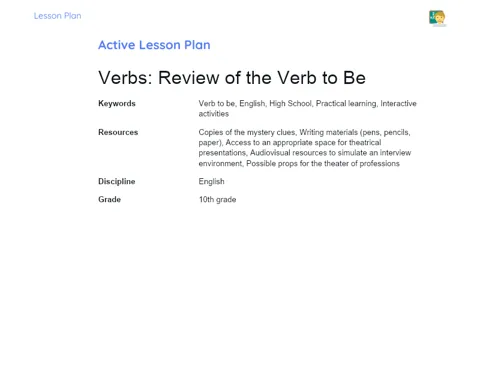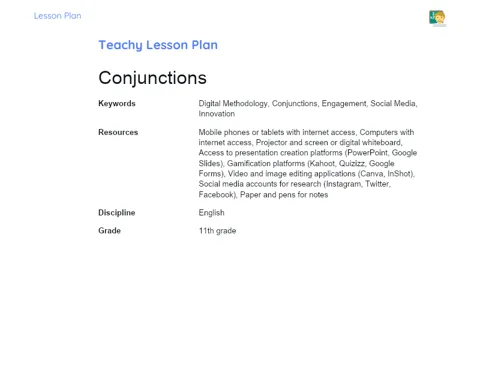Objectives (5 - 10 minutes)
-
Understand the concept of plural in English: The teacher will guide the students to understand the concept of plurality in the English language, emphasizing the main rules for forming the plural.
-
Differentiate the rules of plural between regular and irregular nouns: The teacher will present to the students the differences between regular and irregular nouns regarding plural formation, highlighting the spelling and phonetic changes that occur.
-
Apply the rules of plural in practical situations: Students will be encouraged to apply the knowledge acquired about plural in practical activities, such as writing sentences and texts involving the use of nouns in the plural.
Secondary objectives:
-
Improve pronunciation and fluency in English: By practicing plural formation in English, students will also have the opportunity to improve their pronunciation and fluency in the language.
-
Stimulate critical thinking and problem-solving: The study of plural in English can also be an effective way to promote critical thinking and students' ability to solve linguistic problems.
Introduction (10 - 15 minutes)
-
Review of related contents: The teacher will ask the students to recall the rules for forming the plural in Portuguese, in order to establish a basis for comparison with English. This review can be done through direct questions or interactive activities, such as word games or puzzles. (3 - 5 minutes)
-
Problem-solving situations: The teacher will present two situations that require knowledge of plural in English. The first one may be reading a text in English containing a variety of plural nouns, and the second one may be writing a shopping list or a conversation script, both in English. (3 - 5 minutes)
-
Contextualization: The teacher will explain the importance of plural in English communication, citing examples of everyday situations where the plural is used, such as when talking about family members, animals, objects, etc. The teacher may also discuss the impact of errors in plural formation in formal and informal communication situations. (2 - 3 minutes)
-
Attention gain: To arouse students' interest and show the relevance of the subject, the teacher can share curiosities about plural in English. For example, he may mention how the English language has a wide variety of irregular nouns in the plural (such as "child" becoming "children"), or how some words are used only in the plural in English (such as "scissors" or "pants"). The teacher may also share the curiosity that the word "sheep" is the same in singular and plural in English. (2 - 3 minutes)
Development (20 - 25 minutes)
-
Plural Board Game Activity (10 - 15 minutes):
- Preparation: The teacher will distribute to each group of students a plural board game board, player tokens, a die, and a set of English noun cards. The plural board game board can be created in advance by the teacher, with spaces of different colors, each corresponding to a plural formation rule. The English noun cards should include a mix of regular and irregular nouns.
- Game: Students will play in groups of 3 to 5. Each player, on their turn, will roll the die and advance on the board. When a player lands on a plural formation rule space, they must draw an English noun card and form the plural of the noun according to the rule of the space they landed on. If the player is correct, they stay on the space, if they are wrong, they go back to the previous space. The first player to reach the end of the board wins.
- Discussion and Verification: After the game ends, the teacher will lead a classroom discussion, reviewing the plural formation rules that were worked on in the game and clarifying any doubts that may have arisen.
-
Story Creation Activity (10 - 15 minutes):
- Preparation: The teacher will divide the class into groups of 3 to 5 students and provide each group with a list of English nouns. The list should include a mix of regular and irregular nouns.
- Activity: Each group will have to create a short story in English, using all the nouns from the list. Students must make sure to use the plural formation rules for the nouns correctly.
- Presentation: After completing the activity, each group will present their story to the class. The teacher and other students will pay attention to the correct use of plural in the nouns.
- Feedback and Correction: After each presentation, the teacher will provide feedback to the students, praising what was done correctly and correcting any errors. The teacher may also lead a discussion about any challenges students may have faced when trying to use the plural correctly.
Return (10 - 15 minutes)
-
Group Discussion (5 - 7 minutes):
- The teacher will ask the groups to share their solutions or conclusions from the story creation activity. Each group will have up to 3 minutes to present.
- During the presentations, the teacher will encourage other students to ask questions or make comments about the stories presented, focusing especially on the use of plural in the nouns.
- The teacher may also take this opportunity to highlight notable examples of correct plural use, or to draw attention to common errors that students should avoid.
-
Connection to Theory (3 - 5 minutes):
- After all presentations, the teacher will give a general review of the plural formation rules in English, connecting them with the examples presented in the students' stories.
- The teacher may highlight how the plural formation rules were applied correctly and where there were difficulties, reinforcing the importance of understanding and practicing these rules.
- This moment will serve to consolidate the knowledge acquired by the students, reinforcing the theory with practical and real examples.
-
Final Reflection (2 - 3 minutes):
- To end the lesson, the teacher will propose that students reflect for a minute on the following questions:
- What was the most important concept learned today?
- What questions have not been answered yet?
- After the minute of reflection, the teacher will ask some students to share their answers with the class, promoting a moment of exchange and collaborative learning.
- The teacher will note down the unanswered questions for future lessons, ensuring that all concepts are understood and assimilated by the students.
- To end the lesson, the teacher will propose that students reflect for a minute on the following questions:
-
Teacher's Feedback (2 - 3 minutes):
- Finally, the teacher will provide a general feedback on the lesson, highlighting the positive points and areas that need improvement.
- The teacher may also take this opportunity to reinforce the plural formation rules in English, giving tips and suggestions for the students' continuous practice, whether at home or in future lessons.
Conclusion (5 - 10 minutes)
-
Summary of Contents (2 - 3 minutes): The teacher will give a brief summary of all the contents covered during the lesson, reinforcing the concept of plural in English, the difference between regular and irregular nouns, and the rules for forming the plural. He may use practical examples from the activities carried out to facilitate students' understanding.
-
Connecting Practice with Theory (2 - 3 minutes): The teacher will explain how the practical activities carried out during the lesson connect with the presented theory. He will emphasize that practice is essential for content retention and that the activities allowed students to apply the plural rules in English in practice.
-
Extra Materials (1 - 2 minutes): The teacher will suggest some extra study materials for students who wish to deepen their knowledge of plural in English. These materials may include textbooks, language learning websites, educational videos, online games, and language learning apps.
-
Importance of the Subject (1 - 2 minutes): The teacher will conclude the lesson by highlighting the importance of plural in English communication. He will reinforce that the correct use of plural is essential to express ideas clearly and correctly, and that errors in this area can lead to misunderstandings. Additionally, he may mention how knowledge of plural in English can be useful in various everyday situations, such as reading a book in English, watching a movie or series, or communicating in an international work environment.



